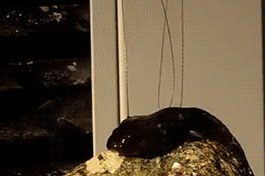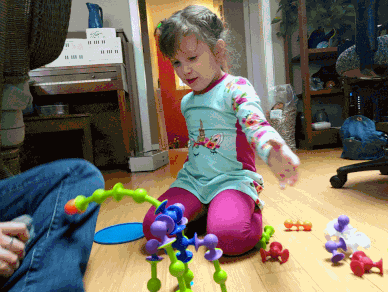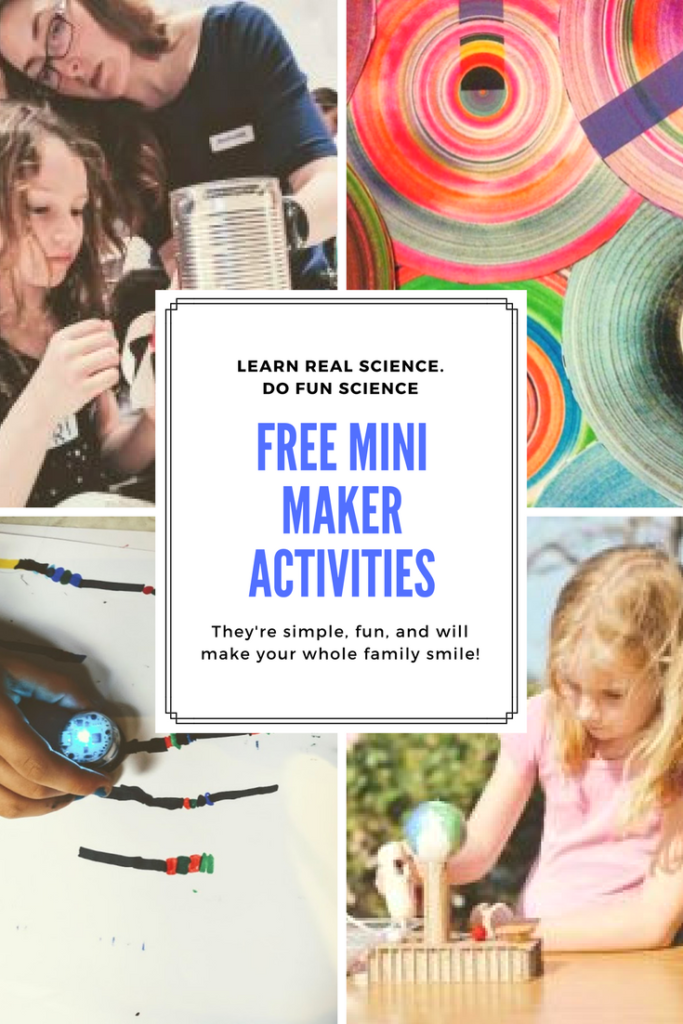 Squigz are a fun building toy that are similar to Lego in that you have plenty of opportunity, but different from Lego in that you connect them through suction instead of friction between dots.
Squigz are a fun building toy that are similar to Lego in that you have plenty of opportunity, but different from Lego in that you connect them through suction instead of friction between dots.
My youngest was given a set of Squigz from her grandma for her birthday, and while I didn’t quite know what to do with them initially, I have since gained a keen liking to them.
Unlike many of the building toys our there, Squigz bend, twist, and stretch. This brings a kinetic element to the building process.
The fact that Squigz connect through suction opens up a whole slew of fun science porjects you can do with them. For example, you can investigate why types of surfaces Squigz can hold on to and discover they need to be smooth, non-porous surfaces. Or your could learn about suction as you research animals that use suction in everyday life. OR you could build a game! There are so many ideas out there!
Below are 5 Squigz based science projects and 5 Squigz based engineering projects to get you started!
5 Squigz Science Project Ideas
- Learn about materials science as you test what surfaces Squigz can hold on to.
- Research animals that use suction and build one of those animals in Squigz.
- Find the sucking power of Squigz
- Look at how the suction of Squigz is changed in air, water, oil, sand, and other substances you can think of.
- Learn how to create your own suction using heat.
5 Squigz Engineering Challenges

- Build a bridge that is 6 inches long and can hold the most weight.
- Create a catapault to launch a pom pom as far as possible using only Squigz and popsicle sticks.
- Build the tallest Squigz tower.
- Create a floating bridge for cars across your bathtub using Squigz and
- Design your own suction cup using balloons and plastic water bottles.
5 Squigz Science Projects Explained
1.Learn about materials science as you test surfaces Squigz can hold on to.
Squigz work through suction, and the amount of suction it can, or can not, produce is dependant on the material it is trying to stick to.
In this project you’ll need two different colors of Post-It notes, I suggest green for objects that Squigz can suction to and red for those it can not.
Choose one room in your house for the project and test anything your heart desires inside that room. As an adult we tend to like to try things we know will work, so you might quickly run out of ideas of suggestions for your kids to try. Let them roam around and have fun with this.
Let them test the couch, book pages, book covers, various toys, the rug, the hardwood floor, game boxes, walls, windows, small objects, large objects, round objects…you get the idea.
Once you have had fun labeling everything make piles of the items that are moveable. One pile for the items that Squigz could stick to, and one pil that they couldn’t.
What sorts of similarities or differences do your kids notice? Does size matter? Shape? Texture?
2.Research an animal that uses suction and make a model of it out of Squigz.
 There are a ton of animals that use suction for survival. This little fish uses a huge suction force to rip apart mollusks, octopuses use suction to grip prey and move around on rocks, and chameleons have a little suction cup at the end of their incredible long tongue to hold on to its food.
There are a ton of animals that use suction for survival. This little fish uses a huge suction force to rip apart mollusks, octopuses use suction to grip prey and move around on rocks, and chameleons have a little suction cup at the end of their incredible long tongue to hold on to its food.
This is a great chance to take a field trip to the library and learn not only about animals that use suction, but also how to find books, talk to librarians and use the library’s catalogue.
Once you have an animal to learn about, make a model as a part of your learning!
3.Find the sucking power of Squigz.
This is a fun one. How hard do you need to pull to get a Squigz off glass? There are a couple of ways to test this. One is if you attach a spring to the Squigz and pull on the spring. The amount the spring stretches just before it pulls away can be measured and turned into a force if you know how stretchy the spring is (called a k constant). For a small slinky (held after 20 turns) the constant is 3 Newtons per centimeter of stretch.
If you measure the stretch and multiply it by 3 you will get how many Newtons of force the Squigz can hold on with.
There are also spring scales you can attach to the Squigz to get a better reading – or if you have both you could compare results.
Finally, for older kids, you could calculate the holding force of the Squigz. Squigz hold on with suction, a force that is caused by a difference in pressure inside the suction cup and outside. This difference is created when you press the Squigz against the wall and let out most of the air inside the suction cup, this creates a mini vacuum.
Force and pressure are related to each other through the area. Force = Pressure/Area. You can measure the diameter of the Squigz, calculate the area, and turn it into a force using a pressure change of 1 atmosphere (using the conversion that 1 atmosphere is 101325 Pascals).
4.Look at how the suction power of Squigz is changed in air, water, oil, and more.
Suction works by pushing air out of the cup area. The air outside the cup then pushes on the Squigz to keep it in place. What would happen if we stuck Squigz to the outside of a glass that was submerged in water? What about in oil? Would the Squigz stick better or worse?
Also, does it matter if you stick the Squigz on the glass after you put it in the water, or should you put it on in the air first?
This is a great chance for open ended experimentation. You can try just water, or experiment with other things like oil, or even sand.
5. Learn how to create your own suction using heat.
For this project you will need a few items, a plate, water, a glass, putty, and matches. Watch the video below to see how to create your own suction and see it with the water. You can also heat up the air in the glass and place it on your hand to feel the suction.
 How does it work? All suction, even you sucking through a straw, depends on air pressure. There are two air pressures at play – the first one is atmospheric pressure. That is the pressure we feel everyday. Atmospheric pressure is what keeps our bodies from boiling away, like they would if we were in space without a spacesuit.
How does it work? All suction, even you sucking through a straw, depends on air pressure. There are two air pressures at play – the first one is atmospheric pressure. That is the pressure we feel everyday. Atmospheric pressure is what keeps our bodies from boiling away, like they would if we were in space without a spacesuit.
The other pressure is the pressure inside the cup. When you heat the air in the cup it moves around faster, and is less dense. Because the cup is still open to the regular air, though, it is still at atmospheric pressure, it’s just hotter, and weighs less.
It is when the cup is then sealed on the plate of water you’ll notice the water starts to go up into the glass. This is because as the hot air inside begins to cool down. Since the hot air was less dense, it has fewer particles of air pushing inside the glass than outside.
The stronger outside air pushes the water into the glass.
Sucking through a straw is very similar. You are sucking out all of the air inside the straw, which makes the outside air stronger and push down on the fluid in the cup, which then pushes the fluid up the straw!
5 Squigz Engineering Challenges Explained
1.Build a bridge to hold the most weight.
This is a fun one, especially with Squigz which are not rigid like most building materials we create bridge challenges out of. For example, Legos, popsicle sticks, or Keva planks are all rigid.
Meanwhile Squigz can bend, bow, stretch, compress and twist. Kids will discover what sorts of challenges this dynamic building material presents to bridge building.
All good engineering challenges have some specifications, and for this one the main one is the distance between the two nearest base pieces. These need to be at least 6 inches apart.
To help kids complete this challenge put a 6 inch square of masking tape in the middle of the table. Their goal is to build a bridge with no Squigz that touch inside this square.
For younger kids that is a perfect challenge. Older kids might want something more added in to their challenge. For older kids you can challenge them to build a bridge that will hold the most weight.
Once their bridge is complete start stacking books on top. You can then weight the number of books it could hold.
2.Create a game using a structure built out of Squigz
 Kids are really great thinking up games, so I have no idea what will come of this project. I do know you can use Squigz to make circles that could be used as targets, create bending towers that you can play a slapping game with, for design silly sticks to bat with.
Kids are really great thinking up games, so I have no idea what will come of this project. I do know you can use Squigz to make circles that could be used as targets, create bending towers that you can play a slapping game with, for design silly sticks to bat with.
But in all honesty, it’s better to let your kids think up the ideas. My girls came up with the slapping game, and I would have never thought of it, but it even got to us drawing out point areas on the floor so you could score points and defend.
What really matters here is that you all have fun with the idea. You don’t need to drive the process, just give them the challenge and see what they come up with. You can provide advice, for example, the girls came up with the back and forth game, and I asked them how we could somehow add points to the game to give it more depth.
3.Build a Squigz tower.
 We have so many play based engineering challenges, and with almost all of them the tower inevitably comes up.
We have so many play based engineering challenges, and with almost all of them the tower inevitably comes up.
I think tower engineering challenges are so fun because it helps kids think about material science, structure, forces, bracing, material availability. I’m sure there is more benefits I’m not listing, but that is what comes to mind right away.
Squigz is a fun tower project because of the limited resources, and also the limited shape types. This adds in an extra element to the tower building, as does the wiggly nature of the Squigz.
You might find kids love using the Squigz cubes, but that will be short lived since there is only two in a set. They will have to be creative on how they brace, and selective about what pieces they put in each position since there is not an unlimited amount of any type.
4.Create a floating bridge using Squigz, cardboard, and tape.
The perfect place for this project is in your bathtub, since you can easily fill it with water, and the walls provide a predetermined length, and anchor, to your bridge.
Using what they learned about how Squigz stick underwater versus in air kids can design their bridge using only Squigz, cardboard pieces (to produce the roadway), and tape (to secure the roadway to the Squigz).
5.Design your own suction cup using balloons and plastic water bottles.
Unlike Squigz that stick to surfaces and can hang, your challenge here will be to create a suction machine that can suck a liquid like water
This is easier than the suction cups that Squigz use because the liquid will conform and seal at the interface of the bottle. Squigz uses flexible silicon to do this job.
This challenge might need some researching about how suction works, and what qualities suction cups, or suction machines use. Doing some of the Squigz science projects above, however, will help answer a lot of potential questions!
Invalid shortcode parameters





1 thought on “Squigz Science: Building and learning with Squigz”
Comments are closed.